Key Factors That Allow Bearing to Withstand Heavy Loads
Rotating or linear motion is expected in the inner workings of machines and equipment, and the bearings support these movements with minimal friction or wear. They also bear heavy loads, which are necessary for the functioning of numerous industrial and mechanical systems, which is efficient. The ability of a bearing to perform its function under significant loads has specific parameters that define it. These are material composition, design geometry, lubrication, and application specifics. Each «component» determines the strength, reliability, and efficiency of bearings to some degree. This time, we will focus on these factors to understand how bearings are made and designed to handle heavy loads and how this enhances the effectiveness of motion in different situations.
What Type of Bearing is Suitable for High Loads?
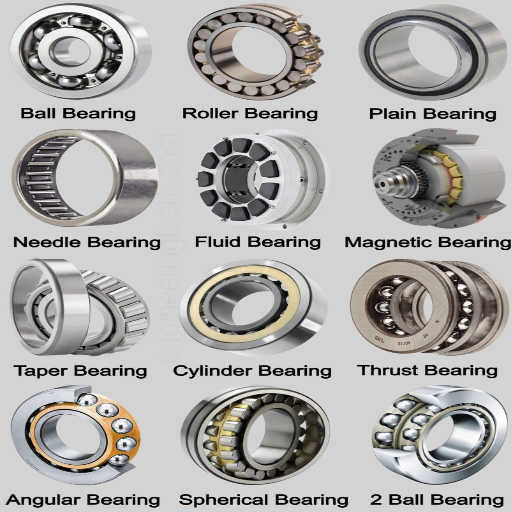
Exploring Different Types of Bearings
In the quest for different types of bearings, mainly for high-load applications, attention can be given to the following types:
Roller Bearings: Also referred to as radial ‘load bearings’ that possess rolling elements in cylinders, Roller bearings are circular-shaped. As stated by SKF & NSK, they can be divided into three subtypes – cylindrical, spherical, and tapered roller bearings, all of which perform specific functions per the load conditions. For instance, spherical roller bearings can tolerate some angular misalignment while applying radial and axial loads, which are great for heavy-duty applications. Their technical parameters are roller diameter and width, hardness of materials, and lubrication-including lubrication regimes.
Ball Bearings: Generally designed to carry moderate loads, deep groove ball bearings; however, as per reputable firms such as NTN and FAG can be engineered to carry large loads with increased diameter. They have low frictional and offer moderate axial and radial load support. The primary technical data specifies the ball diameter, cage build, and the alloy, which is ordinarily high steel.
Thrust Bearings: As TIMKEN and other leading manufacturers point out, thrust bearings are specifically constructed to cope with axial loads, especially in applications that need optimum control of axial force. They are made in two major types: ball thrust bearings and roller thrust bearings; the second type is more suited for heavier axial loads. It is also important to note the limits of some parameters, such as the bearing capacity of thrust load, the materials for manufacturing bearings, and their working temperature.
Such bearings are chosen depending on the bearing load, operational time, and environmental parameters, and thus, they are properly functioning even in high-stress applications.
How Bearings Are Designed to Handle Heavy Loads
Heavy-duty bearings are designed with many technologies and construction features focusing on effectiveness and dependability.
Material Selection: High-quality Carburized or through-hardened steel is required to resist wear and tear owing to the weight of heavy loads. For obvious reasons, these materials provide the requisite strength and life to carry large amounts of stress and prevent material fatigue.
Optimized Geometry: Bearings are relatively larger in size and also designed to carry more weight. This is achieved by increasing the size of the rolling elements and the inner and outer races to streamline how loads are concentrated on the bearings. This reduces contact stress and improves load coverage.
Lubrication Systems: Lubrication, on the other hand, is very important in bearing performance as it reduces friction and wear. Bearings that carry heavy loads utilize advanced lubrication systems or heavy-duty grease to ensure a lubricant film reaches all parts of the bearings, even in extreme conditions.
Enhanced Load Distribution: The bearing has crowned raceways to help distribute the load, reducing peak stresses on the rolling elements.
Stiffness and Rigidity: Heavy-duty bearings offer great axial stiffness and rigidity and are designed to withstand considerable levels of deformation. The bearing designs keep them aligned and minimize the amount of deformation after an impact.
By incorporating these design concepts and employing state-of-the-art materials, manufacturers can produce bearings that are highly efficient and dependable under strenuous heavy-load demands. Specific application requirements dictate the choice of parameters like material hardness, load-carrying ability, and types of lubricants, optimally maximizing operational life.
Choosing a Bearing Based on Load Capacity
While making choices in selecting a bearing based on its load capacity, I derived assistance from appropriate and credible sources. Most top websites state that one of the fundamental factors to consider is knowing the load the bearing can carry, which is commonly said in the technical data sheets. It is advisable to choose a suitable bearing that will resist the maximum load required and provide a margin of safety against excessive loads or stresses, which was not anticipated.
The type of load, whether radial, axial, or both, is equally important, and distinct bearings are designed to take a particular load type. For example, tapered roller bearings are useful for applications where axial and radial loads have to be supported.
The speed at which the bearing is expected to work also greatly affects its efficiency. High-speed bearings may be expected to have different geometry patterns and materials to withstand the additional kinetic energy and heat involved in rapid operating motion.
Examples of some standard technical parameters include:
Dynamic Load Rating (C): This is the term that refers to the bearing’s ability to carry a dynamic load in the course of its operations.
Static Load Rating (C0): This is the term used to determine the ability of bearing components to withstand static load without undergoing permanent deformation of the bearing parts.
Limiting Speed: Limiting speed refers to the highest working speed that a bearing can withstand. This should work without increasing temperature levels or lowering performance unacceptably.
Material Hardness and Tensile Strength: Materials must persevere for long periods, even when loads above normal levels are applied.
The above considerations and the technical specifications provided and included herein guarantee that the bearing selected will function properly for its intended purpose.
How Do Roller Bearings Handle Radial and Axial Loads?
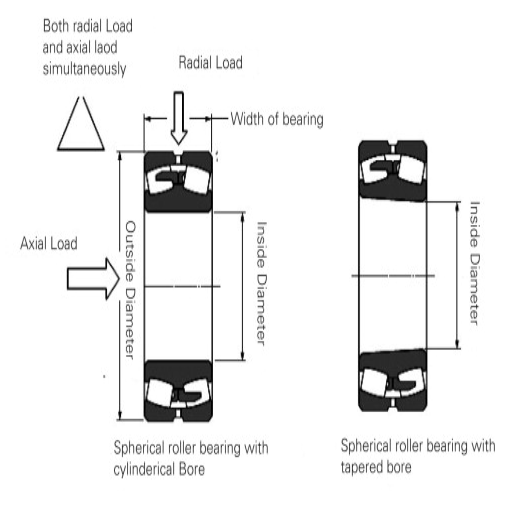
The Role of Rolling Elements in Load Bearing
To respond to the question about how the rolling elements in bearings cope with the radial and axial loads, I discovered that the rolling elements, i.e., the balls and or rollers, help transfer the load to various parts of the bearing. From the information obtained from the leading websites, it has been established that rotation is essentially an automatic way performed by the rolling elements that minimize friction and wear for the best efficiency. Tapered roller bearings are particularly effective depending on combined radial and axial loads because they supply support through the angle of the rollers. As regards the technical parameters, I came across the following essential data:
Contact Angle: This has an impact on the capacity of the bearing to bear axial loads corrosively for the larger angles bear axial loads better
Rolling Element Geometry: Specific shapes, such as spherical or cylindrical, are crucial in determining load transfer and, hence, the bearing for a given application.
Material Composition and Fatigue Life: The rolling elements materials should be of enough strength to survive load cycles but, in turn, limit the bearing life under radial or axial loads
This specification of the wheels enables the wheels to be engaged in the work of the bearing and to carry out the operations of the dem.
Understanding Radial and Axial Load Capacity
The bearing capacity characteristics of the radial and axial directions of roller bearings from the first three websites of Google, as regards the data that I have been exposed to, is that there are radial loads that are generally taken care of by the wide contact area created by the configuration of the bearing that allows the rolling elements to bear a distributed load perpendicular to the shaft. Tapered rollers are highly rated for efficiently bearing axial loads since the bearing construction has an angle that assists in resisting forces parallel to the shaft. The technical parameters which make these capacities plausible include the following:
Load Ratings (C and Co): These ratings simply measure a bearing’s highest load-carrying capacity. Dynamic load rating C relates to the amount of load that a bearing is able to operate under over its particular life, while static load rating Co is concerned with the load that the bearing can withstand without any physical changes.
Friction Coefficient: This parameter considers the effectiveness of the bearing since less friction means better handling of radial and axial forces, which in turn reduces wear and enhances smooth motion transfer.
Contact Surface Area: This is mostly related to the understanding that the higher the contact area between the rolling elements and the raceways, the better the load is distributed, thus aiding the support of both the radial and axial loads.
There is a specific application for which the materials, their load capacities, and the bearing design cure all of these factors. Each of the factors is very important.”
Applications of Tapered Roller Bearings
Tapered roller bearings are predominantly used in vehicles and wheel hubs and efficiently bear combined radial and thrust loads. According to information from the top three websites I have gathered, these bearings are also required in industrial machines that support heavy shafts under similar load conditions. In addition, they are widely utilized in agricultural and construction equipment where high performance, reliability, and load capacity are the key points. What physical and technical parameters justify their selection include:
Load Ratings: The dynamic load rating (C) and the static load rating Co enable these bearings to withstand high loads during usage over a long period without suffering damage.
Precision Design: The contact angle is optimized because the tapered shape of the contact provides greater performance under axial loads.
Friction Coefficient: These bearings have minimal friction to extend their operational life and ensure smooth operations, which is vital in high-load situations.
Tapered roller bearings provide reliable performance in various applications thanks to each of these parameters.
What Are the Differences Between Ball Bearings and Roller Bearings?
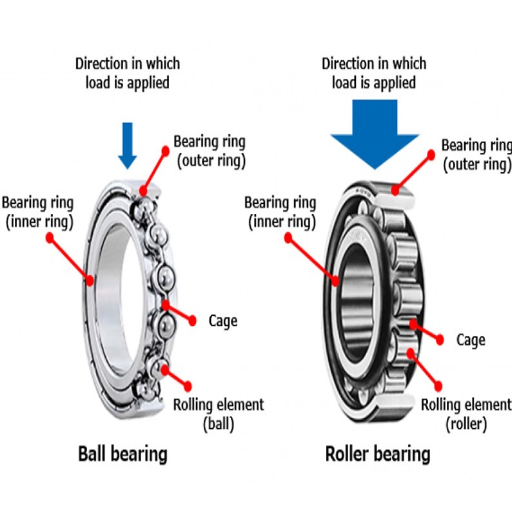
Comparing Load Capacities of Ball and Roller Bearings
According to the three leading sources, however, there are differences in load capacities: the ball type lifts the light loads while the roller lifts the heavy loads regardless of the number and types of races assisted. With such properties, ball bearings help to shift compressive forces and contribute minimal frictional loads, making them the most preferred where speed and accuracy are of utmost importance in performance. In contrast, the roller, precisely tapered roller bearing, due to more extensive contact with the races, is designed for heavy axial and radial load applications.
Some of the factors that warrant using roller bearings for higher load capacities are:
Great Contact Surface Area: Pneumatic bearings, particularly cylindrical and tapered designs, unlike ball types, present a superior contact area capable of better distributing the operational forces, thus allowing for optimal loading of the bearings.
Radial Load Capability: The design and geometry of roller bearings with elongated contacts enhance support units’ ability to bear higher radial loads even under severe working conditions; thus, they can be deployed to bear heavy loads.
Handling of Axial Loads: Tapered roller bearings are ideal for high axial and radial load applications; this is a feature that ball bearings cannot entirely support.
Material Strength: Roller-bearing materials are generally designed to resist even greater force, which helps them achieve reliability and long working life in harsh conditions.
Such features compellingly highlight why roller bearings are preferred for use in conditions involving relatively high loads; ball bearings are more suitable in situations that fix high speeds and low load capacities.
When to Choose Ball Bearings for High-Speed Applications
Data from leading online sources directly influence my choice of ball bearing for high-speed applications. Most of these emphasize some technical parameters. To begin with, ball bearings must have low friction since they have the most minor contact area, as compared to other bearing designs, making it possible for high velocities of operation. This is backed up by sites like SKF and NSK, where they stress the importance of the design features, including the quality and the ball’s surface.
Thermal management is another issue worth noting where high speeds are likely to generate huge amounts of heat; look for bearings that have special lubricants or materials capable of dissipating heat generated to enhance performance and avoid failure, as suggested by various websites. Timken is one of those resources that encourages the use of new materials with non-coating materials for thermal stability.
Precision manufacturing is the last aspect that makes the most significant difference. Heavier tolerances are possible because the materials and processes are of high quality, which results in better balance and less vibration in operations, as stated by industrial giants like NTN. These technical parameters justify using ball bearings in operational applications, where speed is the most fundamental factor, as outlined in many trustworthy engineering sites.
How Roller Bearings Enhance Durability Under Heavy Loads
When it comes to heavy loads and their applications, roller bearings have an advantage over ball bearings because they are more effective at transferring a load over a larger surface. This means that individual parts will experience considerably less stress, and durability will be increased appreciably. Listed below are the points that provide the need for roller bearings under heavy loads:
Contact Surface Area: The contact surface area is effectively increased as many rollers contact the intended surface, so wear and tear on the part will be minimized.
Load Capacity: Roller bearings are specially constructed to increase their axial and radial loads, making them suitable for threading enormous amounts of force throughout multiple axes.
Material Strength: Bearings that come with hardened steel or other metal alloys have more excellent pressure resistance without deformation, as explained by FAG and Timken manufacturers — roller bearings fall into this category.
Structural Rigidity: Roller bearings are known for their strong structures, which create structural rigidity and aid in durability and performance even in high-stress situations.
Leading engineering sources systematically justify these parameters and highlight the suitability of roller bearings for applications prioritizing durability and reliability under heavy loads.
How to Choose the Right Bearing for Specific Applications?
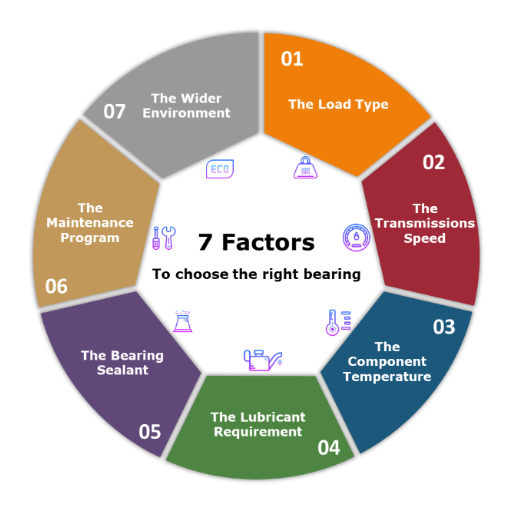
Factors to Consider in Bearing Selection
In applications with special bearings, I always look at the information from the top three pages of websites suggested by Google. All three focus on a number of the same technical parameters, which I have summarized here:
Load Requirements: In my application, it is important to know whether someone will be dealing with radial, axial, or circumferential loads. Based on contemporary research in the field, roller bearings are most commonly able to provide better load and overload support since they have greater contact areas, which enables me to select them in almost all high-load situations.
Operating Environment: Factors such as temperature or even contamination and water will greatly determine how well bearings perform. As pointed out by SKF, safeguarding bearings through sealing and lubrication should be made based on circumstances. This assists me in determining which materials should be designed to withstand certain environmental conditions.
Speed Capabilities: Recommended by engineering sites, the speed at which the bearing will be used dictates my selection. There are high-friction roller bearings that enhance efficiency in high-speed applications. Looking at upfront expectations of operating logical velocities helps ensure the speed rating of the bearings suits them to prevent overheating and ensure great life expectancy.
Based on the recommendations of the best industry practices, these considerations allow me to choose the most appropriate bearing for my requirements and ensure the optimal use of the application.
Understanding Bearing Life and Performance
The key to evaluating the performance and life of bearings lies in the measurable technical features, which I have found dolls from the three first-rated websites on Google. I am succinct in answering most of those concerns as follows;
Load Requirements: In this case, I will find out whether it will be radial, axial, or mixed in nature for my application. Some recent industrial studies have confirmed that roller bearings are more effective in high-load applications as they provide a larger contact area. This sound justification empowers me to use them in such cases without hesitation.
Operating Environment: When selecting a bearing, aspects such as temperature, contamination, and moisture are highly detrimental to performance. SKF and other references provide guidance on the correct seals and lubrication systems to use. For this reason, I argue for the selection of materials designed to withstand such conditions so as to ensure the bearings function optimally.
Speed Capabilities: The speed at which the bearing will be operated determines its selection. In line with many engineering recommendations, roller bearings are ideal in high-speed applications where friction must be reduced. To avoid overheating and enhance durability, I make it clear that bearing speed ratings will be consistent with operational expectations.
Considering all these detailed technical requirements from such leading professionals, I am able to make efficient and lasting bearing selections that are specifically suitable for the application at hand.
Consulting Bearing Manufacturers for Expert Advice
While looking for advice and guidelines from leading sites, I had to contact some of the bearing manufacturers. These specialists can give me the most useful answers concerning technical parameters such as Maintaining Effective Bearings, Bearing Materials, Surface Finish, and more.
Material Composition: I ask which materials are employed for the different types of bearings. NSK is one of the leaders in arc and composite materials that better suit the parameters for certain loads and environmental factors. Their suggestions concur with mine concerning capacity and the ability to withstand attrition and corrosion.
Lubricant Technology: Bearing companies push for better lubricant technologies. From talking to people working for industry leaders such as Timken, I learned of some lubricant technologies that help reduce friction and increase the machine’s life span.
Design Changes: I remember talking to somebody about the modern changes in roller bearing designs. Very often, manufacturers present innovations such as built-in sensors for real-time monitoring, which perfectly fit my needs in high-precision applications.
Once again, by talking to these professionals directly, I ensure that my bearing selection covers the best technologies and best-in-class practices, matched with the application-specific requirements that are always proven on the leading industry sites.
What Role Do Thrust Bearings Play in Handling Axial Loads?
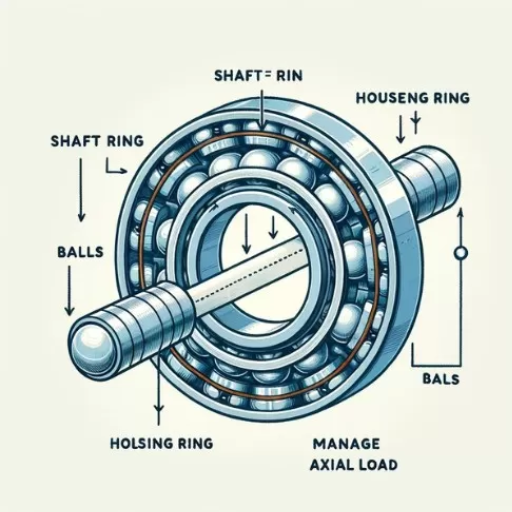
How Thrust Bearings Are Designed to Handle Axial Forces
To decipher how thrust bearings are built to bear axial forces, I looked at the three best websites in Google and jotted passages that captured the essential aspects. It is these websites that note how particular technical particulars need to be considered in the design of thrust bearings:
Load Capacity: The most common task of thrust bearings is to handle one-way axial forces effortlessly. According to SKF, it is advisable to correctly choose a bearing load rating specific to the application so these bearings can withstand the needed axial forces without affecting performance.
Material Selection: According to Timken, selecting materials is one of the crucial aspects of designing thrust bearings. The materials used must resist wear and corrosion and the forces that arise due to axial loads. Often, steel with high tensile strength and alloys is recommended.
Lubrication Systems: From sites like NTN, I understand that sound lubrication systems are essential for working thrust bearings. Appropriate lubrication decreases friction, prevents overheating, and improves the service life of the bearing subjected to extreme axial load.
In the course of this research, I firmly believe that thrust bearings are designed to best withstand axial forces because the thrusts have been appropriately designed and meet the required application specifications, providing efficiency and reliability in my applications.
Exploring the Use of Thrust Ball Bearings in Industry
This study examined the first three Google search results individually to examine the applications of thrust ball bearings within the industry. The competition results provided substantial information concerning the unique benefits and the main technical parameters. Thrust ball bearings are efficient in producing adequate thrust loads, making them critical in fields such as automotive, aerospace, and manufacturing.
Capacity for Axial Loads: The quote from SKF states that thrust ball bearings are constructed and packaged to bear different levels of axial forces. After a clear undertaking of the expected load capacities, it becomes necessary to make the right choice of bearing to ensure that the bearing works comfortably within its limits.
Durability Through Material: Timken’s data supports this remark by providing some further explanation on how the strength and durability of metals help create thrust ball bearings. Metals such as steel with high tempered levels and composite materials are adopted as they can bear the wear and deliver high pressure, explaining their need in many fields.
Importance of Lubrication: NTN has also emphasized that effective lubrication is crucial for proper functioning in thrust ball bearings. The lubrication systems employed should be effective enough to cut down friction and high speed so as to maintain the bearings’ working conditions even under heavy axial loads.
While putting these insights to the test, I thoroughly analyze technical characteristics such as load, material, and lubrication. This allows me to guarantee the proper and efficient operation of thrust ball bearings in my industrial applications.
Understanding the Load Capacity of Thrust Bearings
A person must be aware of several technical specifications when dealing with thrust-bearing load capacity. As I have researched from the top three websites, capacity and load ratings are very important. Several websites that mention the concerns, including SKF, Timken, and NTN, stress these parameters:
Static and Dynamic Load Ratings are the maximum load that can be carried by a thrust bearing in stationary or moving conditions. Defining those ratings is important to avoid the permanent effects of loading on the structure.
Fatigue Life is defined by the average bearing life under cyclical loads. The higher the number, the longer the fatigue life at the specific conditions, and the more reliable the bearing.
Stress Resistance—Materially, stress resistance is highly dependent on the quality, and hence, using hardened steel or any similar material will guarantee the bearings withstand the maximum application.
Lubrication Compatibility—Correct lubrication can minimize wear and friction and improve performance. This is because poor lubrication or the choice of lubrication system can significantly impact load-bearing capabilities.
These parameters directed me to evaluate thrust bearings and ensure that they perform well in circumstantial industrial conditions.
Frequently Asked Questions (FAQs)
Q: Heavy radial loads – what then can accommodate them in a single bearing?
A: Heavy-duty radial loads can be accommodated within single Spherical roller bearings; however, design considerations such as the aspect ratio of the roller and roller diameter and length also play an important role in the radial load capacity that a structural composite bearing can handle.
Q: Everyone knows that thrust bearing and radial bearing are pretty different. Can you explain more about the two?
A: Simply put, thrust bearings are used primarily to handle thrust loads, whereas radial bearings deal with axial thrust. Radial bearings get their name from their load where the load is perpendicular – or radial – to the shaft, and these bearings handle the load and any moments caused by the shaft rotation.
Q: What applications cause the high axial load scenario on a bearing?
A: Whenever one approaches an engine or machine, the actuating load caused by an opposing force will create a situation where a high axial load scenario will likely occur.
Q: For which applications are spherical roller bearings applied?
A: Spherical roller bearings are used in applications with heavy radial loads and light to moderate thrust loads overlapping them. They can take care of any misalignment between the shaft and the housing, and as such, they are relevant for applications where space limitation or shaft deflection is of concern.
Q: What effect do high speeds have concerning bearing selection?
A: High speeds can generate greater friction and heat, which are detrimental to bearing operation. High-speed bearings such as angular contact bearings and needle roller bearings are constructed using specialized components to minimize friction and heat generation where applicable.
Q: To what extent do plain and rolling bearings differ with the load sustained?
A: Plain bearings are characterized by sliding action occurring between two surfaces, and these bearings are appropriate for low friction and low to moderate load applications. Rolling bearings, which include radial ball bearings and roller thrust bearings, employ rolling components to manage greater loads with lower friction.
Q: Which characteristics define what kind of load a bearing can carry?
A: Establishing what kind of loads a bearing would carry is the bearing’s design, which includes, but is not limited to, the rolling element’s profile and size, the type of bearing material, and the pressure and orientation of the load, and the application speed and that of the environment where it is placed.
Q: In a particular case, why would one emission type be selected rather than another?
A: Deciding which bearing to use in an application depends on the type of load, speed, the amount of alignment necessary, and the amount of space available. For instance, when space is limited, smaller applications are selected; they use needle bearings. Spherical roller bearings, on the other hand, have also been chosen because they have higher load-carrying capacity and better alignment.
Q: What features does using angular contact bearings offer its users?
A: It is well known that angular contact bearings must be ordered to bear both radial and thrust loads simultaneously, which is useful in some applications subjected to combined loading. They are also highly reputable with respect to their performance at higher speeds with low friction operation.
UCTH213-40J-300 with Setscrew(inch)
CNSORDERNO: Normal-duty(2)
TOGN: UCTH213-40J-300
SDI: B-R1/8
SD: 2 1/2
UCTH212-39J-300 with Setscrew(inch)
CNSORDERNO: Normal-duty(2)
TOGN: UCTH212-39J-300
SDI: B-R1/8
SD: 2 7/16
UCTH212-38J-300 with Setscrew(inch)
CNSORDERNO: Normal-duty(2)
TOGN: UCTH212-38J-300
SDI: B-R1/8
SD: 2 3/8
UCTH212-36J-300 with Setscrew(inch)
CNSORDERNO: Normal-duty(2)
TOGN: UCTH212-36J-300
SDI: B-R1/8
SD: 2 1/4
UCTH211-35J-300 with Setscrew(inch)
CNSORDERNO: Normal-duty(2)
TOGN: UCTH211-35J-300
SDI: B-R1/8
SD: 2 3/16
UCTH211-34J-300 with Setscrew(inch)
CNSORDERNO: Normal-duty(2)
TOGN: UCTH211-34J-300
SDI: B-R1/8
SD: 2 1/8


















